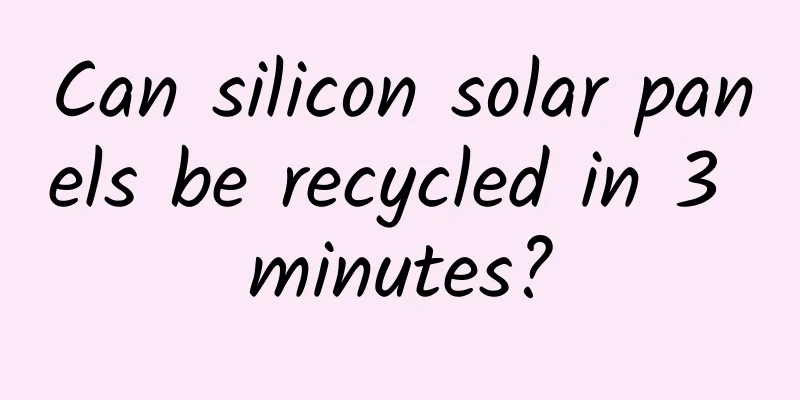Can silicon solar panels be recycled in 3 minutes?

|
Produced by: Science Popularization China Author: Shi Chang (PhD in Physical Chemistry) Producer: China Science Expo Editor's note: In order to understand the latest developments in cutting-edge science and technology, the China Science Popularization Frontier Science Project has launched a series of articles titled "Understanding Top Science Journals", which selects outstanding papers from authoritative journals and interprets them in plain language as soon as possible. Let us broaden our scientific horizons and enjoy the fun of science through the window of top journals. With the rapid development of science and technology, solar power generation technology has gradually entered thousands of households and has become an important choice for us to pursue a green and clean life. Driven by this wave, the production and use of silicon solar panels are soaring at an unprecedented rate, which undoubtedly contributes greatly to the global energy transformation and environmental protection. However, the popularity of solar power generation has also raised people's deep concerns about the disposal of waste panels. So, facing this challenge, we can't help but ask: Can solar panels be recycled? Solar Power (Photo source: veer photo gallery) As a high-tech product, solar panels contain a variety of valuable resources that can be recycled and reused. Metal materials such as silicon, silver, aluminum, and special semiconductor materials are all essential components of solar panels. After professional recycling, these materials can not only effectively reduce the demand for new resource mining and reduce production costs, but also significantly reduce environmental pollution and achieve resource recycling. Solar panels (Photo source: veer photo gallery) The recycling process of solar panels requires several key steps. First, the used panels need to be initially identified and classified so that the appropriate recycling method can be selected based on their material and model. Then, through professional disassembly and separation technology, the various parts of the panels are carefully separated. Finally, valuable materials are extracted and prepared for subsequent reuse. At present, the recycling technologies for waste solar panels mainly include physical recycling and chemical recycling. Physical recycling methods Mechanical force is mainly used to dismantle and separate solar panels, and various materials such as glass, silicon wafers, silver, etc. are classified and recycled. This method is simple to operate, relatively low in cost, and the recycled materials have high reuse value. However, physical recycling methods also have some disadvantages. First, due to the complex structure of solar panels, some materials may be damaged during the disassembly process, reducing their reuse value. Second, physical recycling methods cannot effectively remove harmful substances such as lead and cadmium in solar panels, which may cause secondary pollution to the environment. Chemical recovery methods The useful elements in solar panels are extracted mainly through chemical reactions. This method can extract valuable metals in solar panels and has a high recycling efficiency. However, chemical recycling methods require the use of a large amount of chemical reagents, such as inorganic acids, and the treatment process may produce harmful gases and waste liquids, posing a potential threat to the environment and the health of operators. In addition, chemical recycling methods are costly, have a long recycling cycle, and may lose some useful elements during the recycling process. Waste solar panels (Photo source: veer photo gallery) On June 3, 2024, Chinese scientists published an article in the journal Nature Sustainability on the salt etching method for recycling silicon solar panels, which is expected to recycle silver and silicon in scrapped silicon solar panels without using toxic inorganic acids and without causing secondary pollution. The research results were published in the journal Nature Sustainability (Image source: Nature Sustainability magazine) The researchers used a salt etching method, taking advantage of the fact that molten sodium hydroxide-potassium hydroxide can react with nitrogen silicon compounds, silicon dioxide, aluminum oxide and silicon, to react with the coating on the surface of the silicon solar panel from top to bottom, thereby stripping out the silver wire embedded between the silicon panel and the nitrogen silicon compound. The etching process takes only 180 seconds and achieves recovery rates of up to 99.0% and 98.0% for silver and silicon. In addition, the recycling process also recovers other valuable metals such as copper, lead and tin from the solder strip through the method of "selective oxidation-alkaline leaching-electrodeposition". Unlike the traditional silicon solar panel recycling process, the recycling method proposed in this study does not require the use of corrosive inorganic acids, reducing the generation of chemical waste and pollution to the environment. Moreover, the recycling process can directly obtain silver wire, avoiding the dissolution and deposition of silver, which is more efficient than other recycling methods. Solar Panel Recycling Diagram a. Solar panel recycling process; b. Molten salt etching schematic diagram; c. Solder recycling schematic diagram (Image source: Reference 1) This study also used salt etching to conduct recycling experiments on different types of solar cells. The results showed that the recycling method in this study is applicable to various battery architectures, and the recovery rate and purity of silver and silicon are high, which is a universal recycling method for silicon solar panels. Recycling rates of silicon and silver in different types of solar cells (Image source: Reference 1) The impact of solar power generation on the environment is complex and far-reaching, and the integrity of the life cycle of solar panels has also received widespread attention. We should actively promote solar power generation and give full play to its advantages in environmental protection and energy security, while also paying attention to and responding to its potential environmental challenges, and jointly promote green and sustainable energy development. References: 1. Gao, S., Chen, X., Qu, J. et al. Recycling of silicon solar panels through a salt-etching approach[J]. Nature Sustainability, 2024. 2. Fiandra, V., Sannino, L., Andreozzi, C., et al. End-of-life of silicon PV panels: A sustainable materials recovery process[J]. Waste Management, 2018. 3. Huang Qing, Deng Yi, Yu Fengshan, et al. Recovery of silver from waste solar panels[J]. Nonferrous Metals: Metallurgy, 2022. 4. Long Zhijun, Wang Qiu, Xie Guanjian, et al. Electrical characteristics of silicon photovoltaic cells and solar power generation[J]. Mechanical and Electrical Engineering Technology, 2010. |
>>: Be careful! A "cold" may be fulminant myocarditis
Recommend
The 10 most popular growth hacking strategies in 2018!
We feel it’s necessary to share with you our rese...
Why are there mirrors in elevators? 99% of people can't figure it out!
Source: Dr. Curious...
Tmall Marketing Methodology White Paper
The booming development of the Internet economy h...
If you want users to actively help you spread the word, please do these things first!
When doing operations , one of the most important...
Having trouble with mobile development? Find MDSA! —China’s first Mobile Developer Service Alliance (MDSA) was established
In the past two years, with the fragmentation of ...
Google strengthens the review of external contributors to AOSP to prevent malicious submission of bug code
September 19 news, Android Open Source Project (A...
Appeared in Fujian 96 million years ago? The largest Deinonychus was found from footprints!
In the winter of 2020, a team from China Universi...
Those who know it treasure it, while those who disregard it treat it like a worn-out shoe: Let’s learn about the story of soybeans
In the "National Key Protected Wild Plant Li...
Chemical genius! How did Mendeleev make chemical elements from "chaotic" to "orderly"?
Mendeleev: Founder of the periodic table of chemi...
Where are the entertainment venues in Yuhua District, Changsha?
Content: Changsha Tea Tasting Studio reservation ...
Lithuanian officials urge citizens to throw away Chinese mobile phones
Lithuanian politicians have jumped out again to a...
iPhone 6 released today, said to have changed, scalpers are raising the price to make money
The seller showed the reporter an iPhone 6 protot...
Zhang Ziyi and Gong Li's movie "Memoirs of a Geisha" HD Chinese subtitles
Based on the novel of the same name by American w...
Chery's capital increase and share expansion officially started, and nearly 30% of its shares will be transferred
On September 17, Chery Automobile Co., Ltd. (here...
Download the full set of "Uncle Kai's Sound and Rhythm Enlightenment" audio and listen online to Baidu Netdisk sharing address
Download the full set of "Uncle Kai's So...








![[Popular Science China Star Chasing Dreams] Long Picture | The "Supercomputing Youth" Behind the "God of Calculation"](/upload/images/67f23e5accb52.webp)
